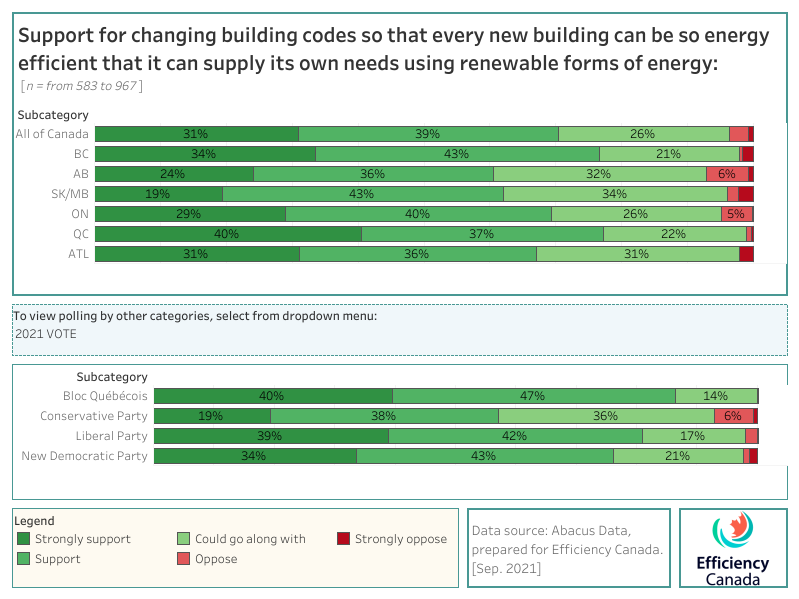Building Codes for New Buildings
The end goal of Canada’s 2020 national model codes is that all new buildings will be built to net-zero energy-ready standards by 2030.
Energy efficiency in new construction is covered under the 2020 model codes. It includes the National Energy Code for Buildings (NECB) for large buildings and the National Building Code (NBC) for low-rise residential buildings.
Existing buildings will be covered under the Alterations to Existing Buildings code, expected to be published by the end of 2024.
In March 2022, the National Research Council published the latest version of the National Model Building Codes for new buildings.
This “2020” version of the codes is an integral component of Canada’s climate action plan.
Why is this version of the codes different?

This version of the model codes includes performance “tiers” with the highest tier consistent with a net-zero energy-ready standard. Net-zero energy-ready means a building is so energy efficient that it can easily supply its own needs over the course of a year with the addition of on-site renewable energy or off-site clean energy.
This version of the code is not simply a minimum standard. It is a pathway to make all new buildings consistent with national “net zero” policy objectives.
This new building code framework is like the British Columbia Energy Step Code first introduced in 2017.
Tiered codes deliver direct and immediate benefits to municipalities
With a tiered code, provinces, territories, and municipalities with jurisdiction over building construction have greater flexibility in how they implement the building code. This aspect of the tiered codes is particularly valuable for a number of reasons:
Municipalities looking to implement aggressive energy efficiency and carbon reduction strategies can choose a tier that meets the knowledge and capacity of their community.
The workforce — carpenters, energy advisors, architects, and more — are given direction and focus to better invest in themselves to build the knowledge and skills that pay off in good local jobs.
It’s easier for utilities and other program providers to align incentives with municipal, provincial, territorial, and federal climate commitments.
Sets a clear path towards an end date, at which point each new building is expected to meet NZER standards. By signalling the desired end state, the 2020 codes provide the time and direction required to build capacity in the market over the coming years.
Fosters market confidence by offering regulatory certainty and an anchor for developing a long-term strategy. Certainty helps builders, developers, and manufacturers prepare to meet the market’s needs, invest in their business, and introduce innovative ways to deliver high-performance buildings.
Municipalities have a standardized path by which to align supplemental standards, such as green development standards. The flexibility to adopt more stringent standards than other municipalities was a key factor in accelerating uptake of the BC Energy Step Code.
Net-zero building codes are supported in all regions
Polling by Abacus data for Efficiency Canada shows that net-zero energy-ready building codes are supported or strongly supported by 60-77% of Canadians in all regions. All provinces have public support in adopting the latest model codes.

The urgent need to accelerate building code adoption
Every new building that is energy inefficient and uses fossil fuels adds to Canada’s GHG emissions. A benefit of the tiered framework is that it can offer municipalities a path to go above provincial minimums, while also maintaining harmonization across the country.
Given the delay in publishing the model code and the promise to speed up adoption by 2025, the federal government has a responsibility to support market readiness in provinces and municipalities.
Efficiency Canada has long-advocated for a Net-Zero Code Acceleration Fund to support activities like studies on costs and compliance, and capacity building in building trades and municipalities. In early 2023, Canada launched a call for proposals for the Codes Acceleration Fund — $100M to help provinces, territories, municipalities, Indigenous governments and stakeholders decarbonize the buildings sector.
How provinces and municipalities can accelerate code adoption
As leaders in climate action, municipalities across Canada can leverage the 2020 model codes to advance building performance — decarbonizing the building sector and reaping the many benefits of the tiered framework for local industries and residents alike. Building codes can reduce emissions quickly, but they often move slowly, limiting the potential impact. Municipalities play a critical role.
Explore our municipal guides for everything you need to know about net-zero emissions building codes.

